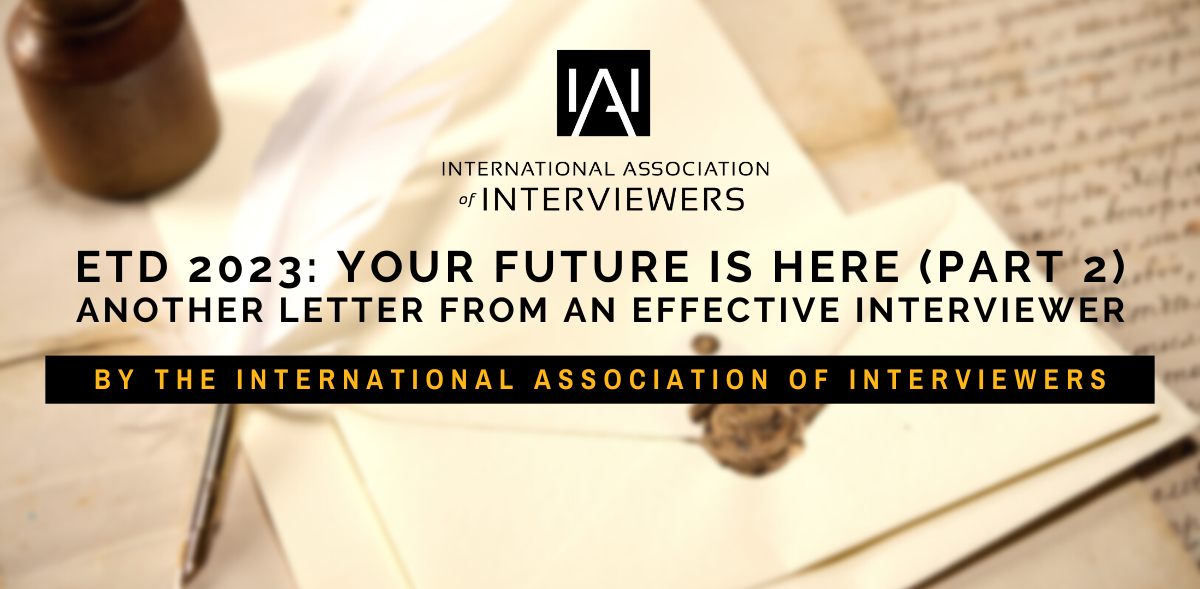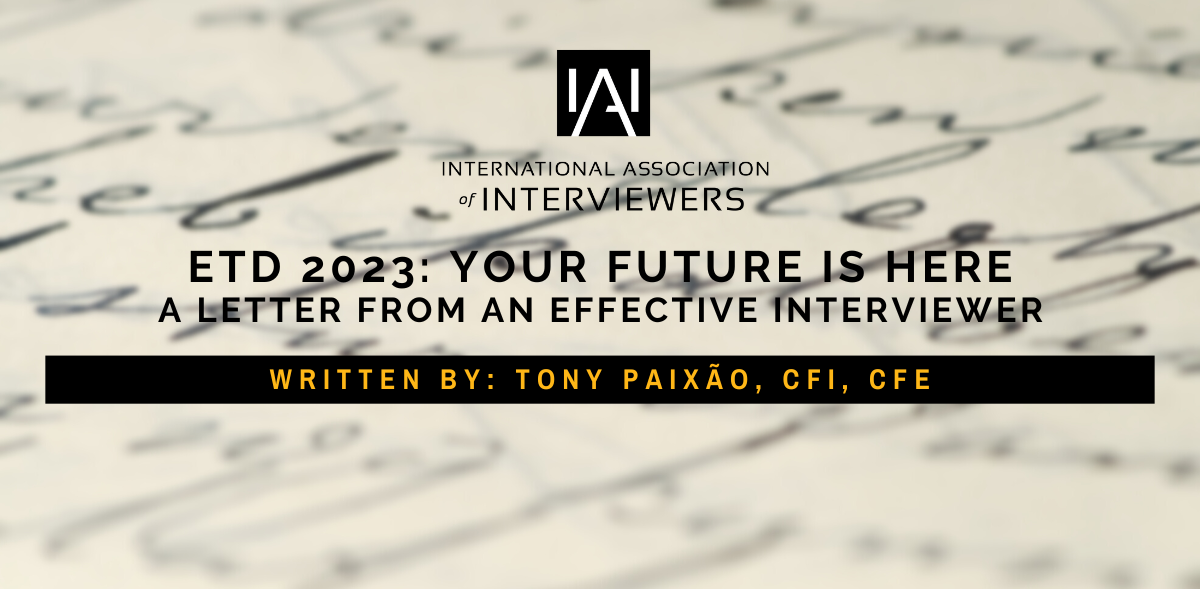“History is a vast early warning system.”
Norman Cousins
History is fascinating. It has a way of enlightening our understanding of the now, while at the same time, giving us motivation and hope for what can transpire tomorrow. Having a historical perspective in and of itself won’t allow for positive change to manifest. It takes knowledge, along with a collective understanding and agreement that things NEED to change, in order to make it happen.
Then comes the hard part—change.
I’m a firm believer, no matter what your professional pursuit, that it’s imperative for you, and those whom you interact with, to have a working knowledge of why you do what you do, the specific way that you do it. Understanding the evolution of your profession will allow you to operate from a position of contextual intellect rather than one of blind action.
I’m going to take you on an abridged journey through the (recent) history of interview and interrogation techniques used in the United States. There are a multitude of books and articles floating around the internet (and—if you dare to venture—actual libraries) that will provide you with a considerably more extensive, unabridged, historical overview of interview and interrogation techniques. My goal isn’t to bring you back to the beginning; it’s to shine a light on how our current methodologies and practices have evolved into what we use today and, if I’m lucky, spark your desire to use the past as a springboard for improving what we do tomorrow.
Close your eyes and picture this:
Imagine it’s 1930. You’ve just been arrested for a crime and two extremely intimidating detectives are walking you into a cold, dark and soundproof interrogation room. You sit down.
Wait! Open your eyes! Open your eyes!
You were just about to be tortured. Whew. Close call. You can thank me later.
The criminal interrogation practices leading into the 1930s resembled something closer to what you may find on a tour of a medieval museum than what we would deem as acceptable practices in 2020. These tactics were exposed on the national platform in 1931 with the release of the Wickersham Commission Report. The Wickersham Commission was a group formed by President Herbert Hoover that was tasked with examining the U.S. criminal justice system under prohibition.
The findings revealed the systemic, nationwide police use of “third-degree” interrogation tactics (among other things).
Though you may associate the term “third-degree” with the time your wife scolded you for not immediately unpacking your suitcase when you got home from your last trip—the expression has an entirely different origin. Used to reference primarily physical and psychological torture, the “third-degree” represents the primitive strategies police employed during an interrogation. The goal of leveraging these methods was, likely at the time, done so with the “best of intentions”—to get a confession.
The Report’s exposure of these practices didn’t, on its face, enact immediate change. What it did do, however, was open the eyes of the public and judicial system to the reality that change was imminent. Physical coercion would no longer be accepted in the American criminal justice system.
Or so we thought.
In the years following, a cascade of case law, set off with Brown v. Mississippi (1936), outlawed the use of “third-degree” tactics, ensuring the rights of all citizens would be safeguarded from unethical interrogation practices (again, so we thought). It didn’t happen overnight, but the landscape of what the courts deemed to be acceptable interrogation techniques evolved by leaps and bounds in the following decades. Now that physical means were no longer in play, the strategy evolved into leveraging emotional connections to acquire information from subjects.
Removing physical coercion was a step in the right direction, but it wasn’t the total solution to the problem. Cases continued to surface where confessions were deemed involuntary due to the use of overt threats, psychological coercion, and a litany of other questionable tactics. As a result, in 1964, the US Supreme Court ruled in Escobedo v. Illinois that all criminal defendants had the right to an attorney during a police interrogation. Two years later, in 1966, the Courts ruled in favor of the defendants in Miranda v. Arizona, extending additional safeguards to the subjects of criminal inquiries.
So, defendants have rights. Now what?
With the ’70s and ’80s came a wave of commonly accepted accusatorial interrogation practices. Specifically, in 1982, yours truly (WZ, not me) came on scene with a new and unconventional approach to the accusatorial interrogation—through a non-confrontational interaction. When Doug Wicklander and Dave Zulawski created the “introductory statement”, they differentiated themselves and the brand from other training providers by offering a non-confrontational technique to both the private and public sectors.
While both the confrontational and non-confrontational techniques were void of physical coercion, there was still possible risk if they were misused to obtain a confession from the accused, no matter the cost.
Enter: False Confessions find the Spotlight.
Though they’ve been around since the dawn of conversations, through the ’80s and early ’90s, false confessions were beginning to find a place on the international stage. England and Wales specifically had experienced a handful of high visibility cases that were overturned as a result. In response, countries throughout the UK joined forces to develop an effective method for interrogating subjects, only doing so without the presence of an accusation.
Thus, the birth of the investigative interview model known as the PEACE (Planning and preparation, Engage and Explain, Account, Closure, Evaluate) Method came to be. This method is still used today throughout the UK, along with a handful of other countries around the globe.
The PEACE method isn’t the only type of “investigative interview” out there, however. There are many methodologies in existence today that find their roots in leveraging fact-finding strategies, rather than accusatorial techniques.
One of the primary investigative interview methods used in the US (and around the globe) is known as the Cognitive Interview (CI). Introduced in the mid 80s, this method, developed by Ronald Fisher and R. Edward Geiselman, intended to blend fact-finding interview strategies with a cognitive psychological perspective for enhancing the efficacy of memory retrieval.
In layman’s terms—a method of communicating that helps the subject remember things they otherwise couldn’t have on their own.
Since the 90s, the training in the US has leveraged the traditional aforementioned accusatorial methods in conjunction with a handful of more progressive investigative interviewing techniques. When it comes to choosing the most appropriate accusatorial method, the two primary options available are the confrontational approach and the non-confrontational approach.
We tend to be partial towards non-confrontational, but you probably already knew that.
Throughout the 90’s and early 2000’s, the use of DNA testing to corroborate evidence in the criminal justice system shined a long-overdue light on the severity of the false confession epidemic right here in the US. This realization only further reinforced the need to shift away from confession-driven, confrontational interrogation practices to those rooted in truth-seeking, non-confrontational, fact-finding techniques.
Remember when I mentioned physical coercion was no longer an acceptable technique to use during an interrogation? Enter, September 11, 2001.
Immediately following the attacks on 9/11, President George W. Bush approved the PATRIOT Act. This opened the door to the eventual implementation of what came to be known as “enhanced interrogation techniques.” These “techniques” utilized both physical and psychological torture in the hopes of extracting actionable intelligence from suspected terrorists.
So, what was the big deal (outside of the obvious moral and ethical issues?)
They didn’t work (entirely.)
Fast forward to 2009, when—based on the findings from an exhaustive government-led investigation—President Obama created the task force that eventually led to the establishment of the High-Value Detainee Interrogation Group, otherwise known as the HIG.
The role of the HIG is twofold. First, they conduct ethical interrogations to collect actionable intelligence on high-value targets. And second—they research current interrogation methodologies and develop evidence-based, effective approaches to be shared with the public.
This brings us to today.
The interview and interrogation landscape of 2020 America is one of contention, reflection, and most importantly—change.
The interrogator’s focus is shifting away from being confession-oriented and moving towards where it should have been from day one: finding the truth. We’re accomplishing this by providing a suite of non-confrontational interview methodologies to choose from, dependent on the nature of the interaction. Being tied to one singular accusatory method can lead the interviewer to possibly leverage a technique that may not be the most appropriate option for the case at hand.
Outfitting interviewers with as many tools as possible to get to the truth is the goal.
It’s not as easy as merely “providing options”. This task requires forging partnerships between academics, training institutions, law enforcement agencies, the private sector, and beyond. In doing so, we improve upon our current methodologies—while at the same time create new techniques aimed at reducing the occurrence of false confessions while increasing the likelihood of obtaining truthful ones.
That’s great, Tony. But what happens next?
What the future holds for the interview and interrogation landscape is up to all of us. As practitioners in this industry, we must continuously push the status quo and ask the question, “How can we do better?”
Improvement and intentional evolution come from being educated on what brought us to where we are today, while at the same time, having the foresight to anticipate what may be coming around the corner tomorrow. In the last few years, with the upsurge in digital communication and the viral spread of content, the general public has been exposed to the tragic reality of what can happen should an individual be subjected to interrogation techniques that don’t appropriately meet the situation at hand.
I like to believe that we’re all in this for the same reason—to do the right thing.
This is only possible by offering training that meets current demands, is rooted in evidence-based best practices, and is delivered in a manner that stresses the necessary safeguards that need to be implemented before ever engaging in the interaction in the first place.
In the not-so-distant future—we will see targeted efforts to increase awareness from both a “top-down” and a “bottom-up” approach. It’s imperative to educate the decision-makers on the importance of implementing a robust interview training curriculum to outfit their teams with the resources they need to complete their jobs. We will also see increased attention targeting those individuals who are new to the industry, both at the college and academy levels. Getting grassroots exposure to best practices and developing an understanding of how to effectively communicate will pay dividends for the coming generations.
The training options available to the consumer will also continue to evolve.
Virtual education will not only provide new and innovative ways to train current consumers, but it will act as a venue for introducing training to those who may never have been previously reached.
Education is the first step. Implementation follows suit.
We will continue to see an increase in the partnerships between practitioners and academics in the effort to further understand what methodologies are the most ethical and effective in obtaining the truth. We will continue to research and implement a suite of interview methodologies to provide a proper perspective for the dynamic range of scenarios our consumer base finds themselves in. From trauma interviewing, to tactical field interviews, to fact-finding and accusatorial—the variety of methods both researched and taught to the public will continue to grow and evolve.
The surge toward ALL interviews and interrogations being recorded, both in the public and private sectors, will continue to move forward—eventually becoming legally mandated (at least for the public sector).
As the increase in visibility and awareness continues to grow within interview/interrogation training, we can expect to see a proportionate influx of new providers to hit the scene—each offering the next “best and brightest” tools to get the job done. As with anything, the impetus will lie squarely on the consumer to ensure they are educated, aware, and understand what programs best meet the needs of their respective organizations.
As for WZ—we will continue to lead the way as thought leaders. We will challenge ourselves to reflect on historical standards, question current practices, and innovate to provide the next wave of professionals with the most effective training available to get the job done.
Stagnation breeds complacency.
We will keep our eyes focused squarely on what lies ahead while being purposeful not to lose sight of the history that paved our way here.
Tony Paixão, CFE, CFI, is a Certified Forensic Interviewer, speaker and consultant for Wicklander-Zulawski & Associates, Inc. (WZ). Tony has served in a variety of roles both in the public and private sectors. He is also an active member of the International Association of Interviewers (IAI). Tony has conducted investigations and interrogations for hundreds of cases ranging from retail fraud to homicide to sexual assault and employee relations matters.





February 11, 2020, 11:02 pm
Hi Tony,
Thank you for the beneficial information you shared during the Dallas class. Definitely some elements and components I plan to utilize in my role.
February 15, 2020, 8:07 pm
Great content! Super high-quality! Keep it up! 🙂